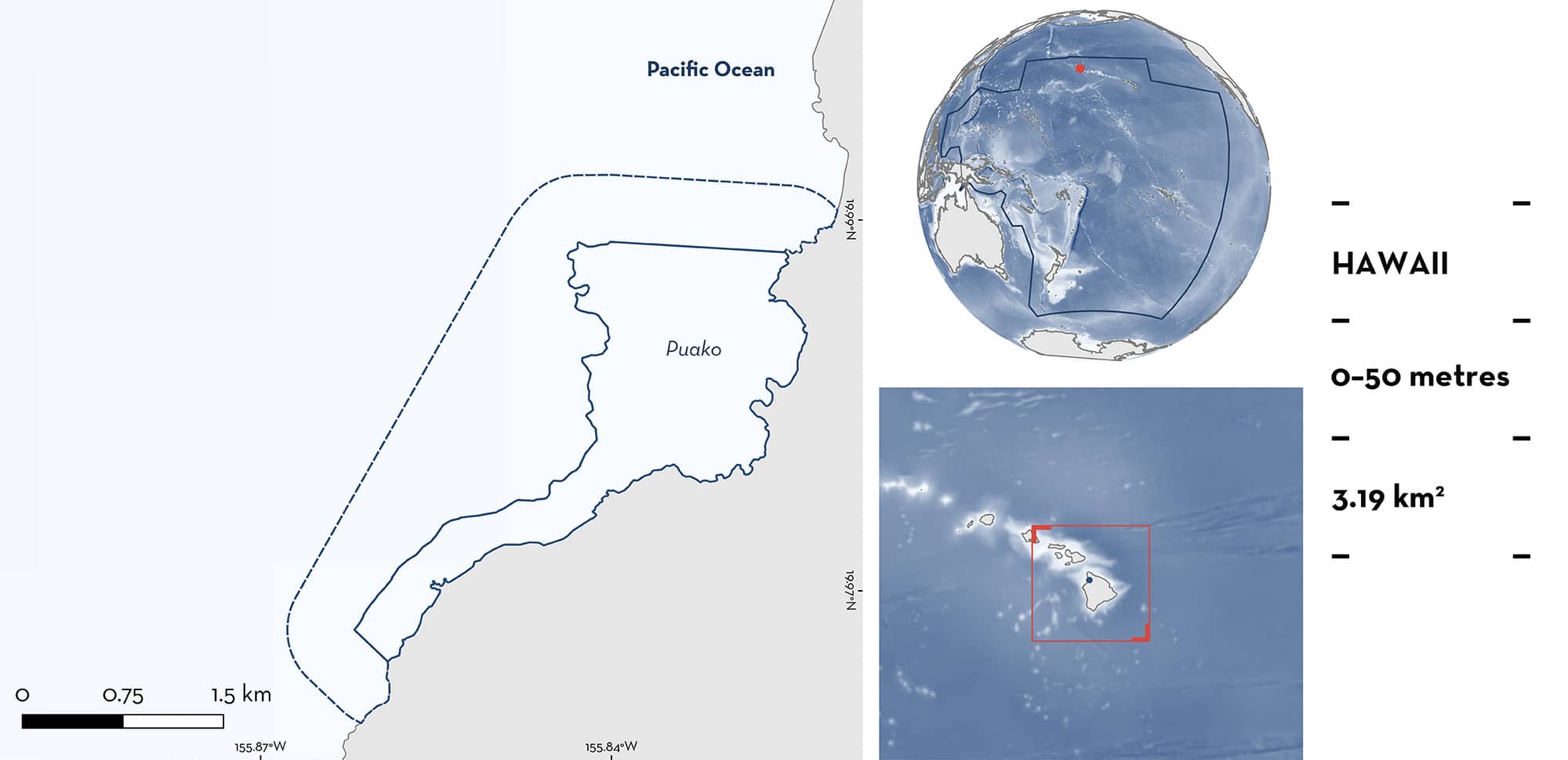ISRA FACTSHEETS
ISRA FACTSHEETS
NEW ZEALAND & PACIFIC ISLANDS REGION
Puako
Summary
Puako is located off the Kohala Coast of the Big Island of the Hawaiian Islands of the United States of America. The area is characterised by a fringe reef that runs parallel to the shore. The area is reported to sustain one of Hawaii’s healthiest coral reefs. The area is influenced by strong currents in boreal winter, and milder currents in summer. Within this area there are: threatened species (e.g., Reef Manta Ray Mobula alfredi) and feeding areas (e.g., Spotted Eagle Ray Aetobatus ocellatus).
Download factsheet
Puako
DESCRIPTION OF HABITAT
Puako is located off the northwest coast of Big Island, Hawaii, an island state of the United States of America. Puako is situated off the Kohala Coast and is characterised by a fringe reef that runs parallel to the shore (The Right Blue 2007). The area is reported to sustain one of Hawaii’s healthiest coral reefs (Yoshioka et al. 2016) which are comprised mostly of Finger Coral Porites compressa (The Right Blue 2007). The area is influenced by strong currents in winter, and milder currents in summer (Hawaiian Planner 2024).
This Important Shark and Ray Area is benthopelagic and is delineated from inshore and surface waters (0 m) to 50 m based on the bathymetry of the area.
CRITERION A
VULNERABILITY
Two Qualifying Species considered threatened with extinction according to the IUCN Red List of Threatened Species regularly occur in the area. These are the Endangered Spotted Eagle Ray (Finucci et al. 2024) and the Vulnerable Reef Manta Ray (Marshall et al. 2022).
CRITERION C
SUB-CRITERION C2 – FEEDING AREAS
Puako is an important feeding area for two ray species.
Spotted Eagle Rays are regularly and predictably observed feeding in this area, sometimes in aggregations. Between 2019–2024, Spotted Eagle Rays were regularly observed by recreational divers who undertake ~100 dives per year (J Glazner pers. obs. 2024). During these dives, there were 50 sightings per year of up to five Spotted Eagle Rays at one time. Of these sightings, Spotted Eagle Rays were observed feeding on ~50% of dives undertaken in this area. Spotted Eagle Rays are seen digging through sand and rubble in this area year-round (J Glazner pers. obs. 2024). This species is observed elsewhere in this region, but this location appears to be important for feeding purposes.
Reef Manta Rays regularly and predictably feed on zooplankton in this area, sometimes in aggregations. Between 2019–2024, Reef Manta Rays were observed seasonally by recreational divers who undertake ~100 dives per year, year-round (J Glazner pers. obs. 2024). During this period, there have been 30 sightings per year while diving, of up to five Reef Manta Rays at one time (average = 1–2 individuals). Of these sightings, Reef Manta Rays were observed feeding at the surface, over the reef, on ~33% of dives undertaken in this area. Almost all Reef Manta Rays are observed feeding during the summer months (from June–October) (J Glazner pers. obs. 2024). Further, this area is particularly important as there are fewer records of Reef Manta Rays (of which are not observed feeding) from dives undertaken in adjacent areas (J Glazner pers. obs. 2024). While the exact environmental conditions and oceanographic features driving local plankton abundances in this area remain unknown, the resulting abundance of Reef Manta Rays has been regularly documented across multiple years.
Download factsheet
SUBMIT A REQUEST
ISRA SPATIAL LAYER REQUEST
To make a request to download the ISRA Layer in either a GIS compatible Shapefile (.shp) or Google Earth compatible Keyhole Markup Language Zipped file (.kmz) please complete the following form. We will review your request and send the download details to you. We will endeavor to send you the requested files as soon as we can. However, please note that this is not an automated process, and before requests are responded to, they undergo internal review and authorization. As such, requests normally take 5–10 working days to process.
Should you have questions about the data or process, please do not hesitate to contact us.


